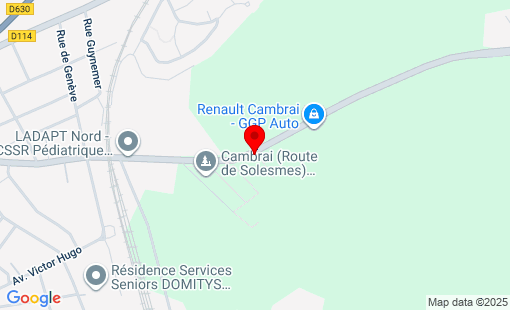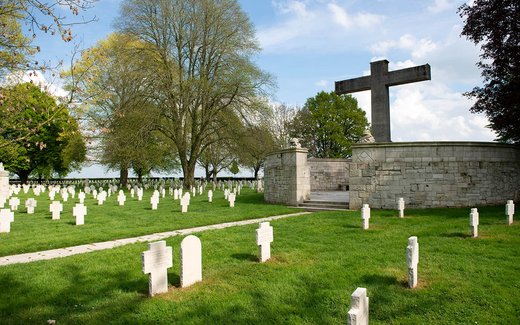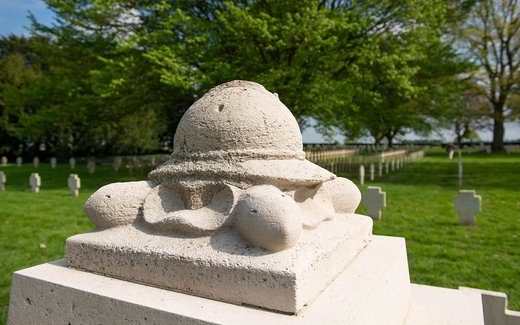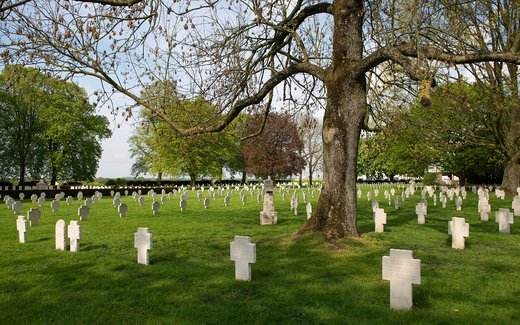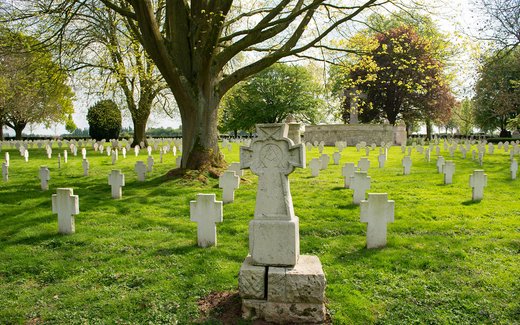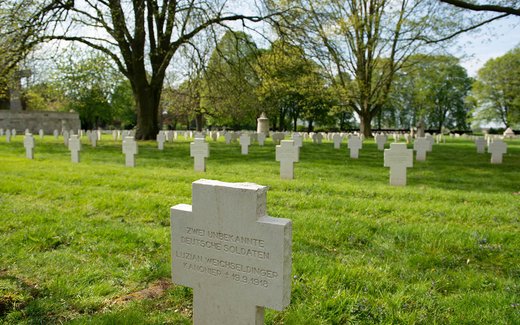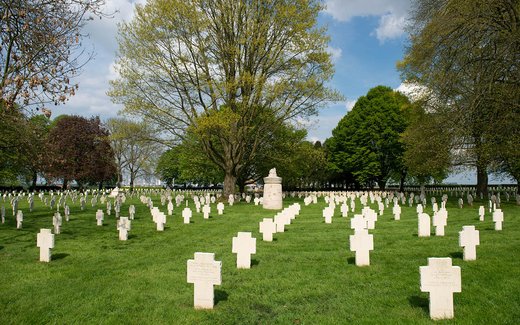Since September 2023, this burial site has been a
UNESCO World Heritage Sites.
Burial
On the "Route de Solesmes", 10,685 German war dead, 502 British
War dead, 502 British, 192 Russian and 6 Romanian casualties from the First World
From the First World War are buried here.
Of the 10,685 German casualties, 7,939 are buried in individual graves. Of these
242 remain unknown. There are 2,746 victims buried in the common grave. Only
442 are known by name. The 26 graves of fallen Jews were
were given a gravestone made of natural stone instead of a cross for religious reasons
Natural stone.
History
The German military cemetery in Cambrai was established by the German troops in March
1917, after the first site at the Porte-de-Paris was occupied.
At the time, Cambrai was the center of military command posts, supplies and hospitals
and military hospitals. Wounded Germans, French and English alike were treated here
were cared for here. Those who died were given a grave on the new common
War cemetery.
Prof. Dr. Wilhelm Kreis - architect and co-founder of the Volksbund in 1919
German War Graves Commission - designed the memorial in 1917, which is still the focal point of the site today
is still the focal point of the site. Other small memorials were also erected by the
Erected by the Germans where enemy soldiers had been buried.
The number of burials increased with the battles at Arras in April 1917
and the British attack on Cambrai in November with the first mass
Mass deployment of armored fighting vehicles and the counterattack in December 1917.
The German offensive in March 1918 and the defensive battles in September and October
October 1918 also claimed many victims.
The troops resting in Cambrai belonged to units whose home garrisons were in
and Prussian provinces in what was then the German Reich
were located. The cemetery is also the resting place of members of the "Boelcke Hunting Squadron", who were
was stationed in Cambrai for some time. Some of those who died in 1918 belonged to
Units that made their first appearance on the German side at this time: heavy
German side at this time: Schwere Kampfwagen-Abt.15, Panzerwagen-Abt.11,
Marine regiments 1 to 3.
The French military authorities expanded the cemetery in the years
1921 to 1924 by reburying German war dead who had previously been buried in the region
buried in civilian cemeteries and temporary field cemeteries in the region or whose
remains were later found in the battle zones. This also brought
Fallen from the war years 1914 to 1916 came to Cambrai.
The British cemeteries were designed by the Commonwealth War Graves
Commission with specially designed grave steles and a memorial in the shape of a Celtic cross
of a Celtic cross.
Initial work to improve the condition of the cemetery was carried out by the
Volksbund in the 1930s. The basis for this was an agreement with the
french military authorities in 1926. The problem of permanently marking the graves remained unresolved
of permanently marking the graves remained unresolved due to a lack of foreign currency and the
Second World War from 1939.
After the conclusion of the Franco-German war graves agreement of July 19
1966, the Volksbund - financially supported by the German government - began
began the final landscaping of the German military cemeteries in France.
It added trees and bushes, renewed the hedges and planted the entire graves with greenery
the entire area of the graves.
From 1977 onwards, the Volksbund replaced the previous temporary grave markers made of
Concrete and wood for natural stone crosses with engraved names and dates
Dates.
Special feature
In September 2023, UNESCO designated 139 cemeteries from the First World War as
Declared World Heritage Sites. 24 German graves are in the care of the
Volksbund Deutsche Kriegsgräberfürsorge e.V. - Cambrai is one of them.
